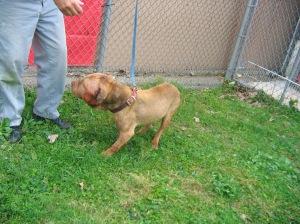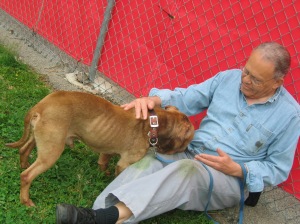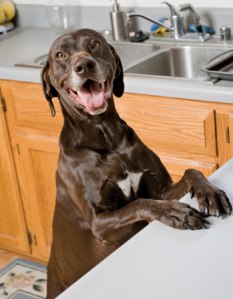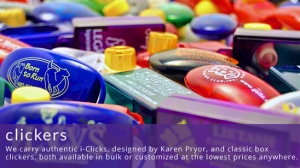I want to post the story of Wonder. This story has traveled around the U S and a few foreign countries. It is a story of one of twenty-five dogs rescued from a dog-fight ring. It is a story that both broke my heart and enlarged my soul. Two of these pictures are me taking Wonder outside. He hardly knew what to do on the grass because his life had been in a cage or a fight-ring. He never knew what play is or what a toy was for.
One day I wanted to take Wonder to a place very quiet. I thought he could rest and 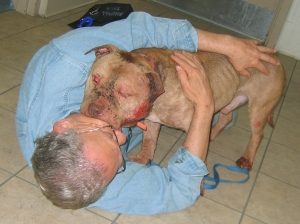 relax away from the din. This picture is of Wonder with me in a hallway. He rested his head on my neck. We were like this for about 45 minutes. When I got up my shirt was covered with blood and puss oozing from the many unhealed wounds on his head, He is VERY dog aggressive. A dog was walked within a couple of feet of us, he looked at the dog, and laid his head back on my neck. Wonder died the afternoon of this picture.
relax away from the din. This picture is of Wonder with me in a hallway. He rested his head on my neck. We were like this for about 45 minutes. When I got up my shirt was covered with blood and puss oozing from the many unhealed wounds on his head, He is VERY dog aggressive. A dog was walked within a couple of feet of us, he looked at the dog, and laid his head back on my neck. Wonder died the afternoon of this picture.
When the story of Wonder hit the papers and the net a man called me, deeply touched by the story. He asked if he could claim the ashes and have the urn made. This is a solid oak box. “In Remembrance of Wonder” is routed on the top. It is a keepsake.
I will here share with you the story of WONDER. This is the INTRODUCTION and First Chapter to the book I am writing about this marvelous dog.
WONDER
FROM UNDERDOG TO “WONDERDOG”
A TALE OF TWO WINNERS
by
JAMES TURNER, MCL, KPA-CTP
Have you ever experienced a kairos moment? A kairos moment is an ancient Greek word meaning “a moment in time” in which something special happens. Kairos time has a qualitative nature that is experienced, but cannot be fully explained. It is an experience that, in some way, changes the person. It seems that time as we know it is suspended and one is absorbed in something of the divine. A kairos experience is not a common occurrence, nor is it a natural experience. Kairos is a supernatural experience and therefore, to fully explain what took place, is beyond human words and understanding. Often, when one tries to explain the experience, it can become lost in words.
Now this story is about a man and a dog brought together in a Kairos moment. The man was no one special, an unknown. The dog was not a Rin Tin Tin or a Lassie which saved lives and received awards and loved by a whole generation. The human mind would think, “If, if God cared about an animal it would not be this animal.” The Bible states that God cares about the Sparrow that falls from the sky. There is an account of George Fox, who, as a boy, threw a rock and killed a bird. He began to weep because he knew he had killed something of the divine. However animals differ from humans they are yet God’s creation. St. Francis of Assisi taught that all of life is sacred.
This story is about a man unknown and a worthless dog, brought together in the wonderment of a kairos moment, a moment in which God bound together the heart of a man with the heart of a dog, and gave this dog meaning, worth, and value. This dog was a part of what was before, and now is a part of what came after. His story helps us understand how something bad can transition into something good. I want to tell the story about an underdog that became a “wonderdog,” and, from him, some lessons we can draw.
in something of the divine. A kairos experience is not a common occurrence, nor is it a natural experience. Kairos is a supernatural experience and therefore, to fully explain what took place, is beyond human words and understanding. Often, when one tries to explain the experience, it can become lost in words.
Now this story is about a man and a dog brought together in a Kairos moment. The man was no one special, an unknown. The dog was not a Rin Tin Tin or a Lassie which saved lives and received awards and loved by a whole generation. The human mind would think, “If, if God cared about an animal it would not be this animal.” The Bible states that God cares about the Sparrow that falls from the sky. There is an account of George Fox, who, as a boy, threw a rock and killed a bird. He began to weep because he knew he had killed something of the divine. However animals differ from humans they are yet God’s creation. St. Francis of Assisi taught that all of life is sacred.
This story is about a man unknown and a worthless dog, brought together in the wonderment of a kairos moment, a moment in which God bound together the heart of a man with the heart of a dog, and gave this dog meaning, worth, and value. This dog was a part of what was before, and now is a part of what came after. His story helps us understand how something bad can transition into something good. I want to tell the story about an underdog that became a “wonderdog,” and, from him, some lessons we can draw.
Chapter I
A DOG WITH NO NAME
The police were called with a complaint of a barking dog. When the police arrived they realized this was more than a dog barking, they walked right into a dog – fighting ring. What the police found was horrific. Twenty-five pit bull terrier type dogs were stuffed in cages in a trailer, a garage, and chained in a fenced in area. There was no heat, electricity, or air conditioning. The dogs ranged in ages of six months to five years. Two of the dogs were shipped in from the Dominican Republic. All of the dogs required medical attention; a few of the dogs were severely scared and bleeding from open wounds. One dog suffered from flexural deformity, walked like a seal, and was used as a bait dog. The overwhelming malady suffered by these dogs was extreme fear. Different dogs tried to find corners in which to hide. They cowered in their cages, shaking uncontrollably. Their ribs exposed, they were starving, and yet eating made them sick.
The police called in the director of Animal Control, and helped in rescuing these dogs by relocating to the city shelter. This process was further traumatizing for each of these animals. The fear and the uncertainty for these dogs were horrible. Each animal was given a number by which they would be referred. None of these dogs had a name or an identity. Gratefully our Mayor, and Director of the shelter, considered euthanasia a last resort. Aside from the legal needs, the director of the shelter where the dogs were housed wanted to know if these dogs could be rehabilitated and possibly be placed in homes. The following day I was contacted and asked if I would evaluate these dogs. I was unprepared for what I would see.
The first dog I saw was the dog used for baiting. I’ll talk about this in another chapter. The first words out of my mouth were, “Oh, my God.” Suffering with Carpal flexural deformity, this beautiful female walked like a seal. This little dog was so frightened I was concerned her heart would fail. To properly evaluate these dogs I would have to wait for, at least, three days for their chemistry to settle in their new environment. In the meantime I wanted to meet each dog and make cursory notes.
I began my rounds with the only puppy among these twenty five dogs. This coal black puppy was about ten weeks old. She was jumping, barking, and stealing the hearts of all the workers. She was refreshing to observe in the midst of so much sadness. She was saved from a life of abuse and suffering and would go on to have a life of love and affection. Not going through a travelogue of all the dogs, you will understand that tears became a silent communication of heartache, and I am convinced that each dog understood. Each dog had a number to which we referred. Number 5 had an eye injury, several scars, and stayed at the back of its cage, shivering in fear. Number 11 invited human contact. This beautiful brown and white male needed assurance that he would be okay. His face was covered with scars and a large portion of his lip was gone.
Number 19 was in the perhaps in the worst physical condition of all. His face and body were covered with about 100 scars. There were at least 30 open wounds on his face. His head was swollen and worsening by the hour. There he stood, hugging the back of his cage, his bleeding head down, avoiding eye contact. It was as if he didn’t see me, I was not there. Yet, it was as if I could hear this dog communicating to me, “Please help me.”
When I talk about Number 19 I will be accused of anthropomorphizing. Anthropomorphizing is the practice of attaching human behavior and thinking to an animal. Some pet owners will say, “When I come home and see my trash can turned over, my dog cowers with guilt.” Many of these feelings we attach to our pet are just too sophisticated for the animal brain. This “guilt” is fear because the owner has scolded or rolled up the newspaper the last time this happened. However, dogs do process information much the same way as humans. Just when someone says, “That is way beyond a dog’s ability,” a dog somewhere, will surprise us. We have not yet fully tapped into the capabilities of these wonderful animals. But they are animals. They are not humans in a furry body. We can attach human qualities to our dog that does no harm. But we, also, can attach human qualities to our dog that will harm it emotionally, and create unnecessary stress and behavioral issues.
That being realized, back to Number 19. When I approached his cage there was a totally different energy, I would describe what I felt as something spiritual. Was it in his eyes, my heart, or in both? Whatever it was, or wherever it was from, the energy was distinct. But there was such a barrier of fear, as though something evil had been experienced by this dog. This dog knew something of the dark, sadistic side of life. It was a side of life that life was never created to know.
Why Number 19 gripped me so, is not fully understood. As I stood in front of his cage, there was something happening that God wanted to do, both in my heart and this dog’s life. It was something beyond me. It would be this dog that would change my heart, the heart of thousands, and would put the abuser of these dogs in prison. But more importantly, THIS dog with no name would get a name. THIS dog would touch the lives of thousands all across our country. It was as if God wanted to put a face, a value to all of these unfortunate dogs. THIS dog, which was a part of what was before, would now be a part of what comes after. But for now, this dog with no name has no identity, any value or worth. NOT YET!

